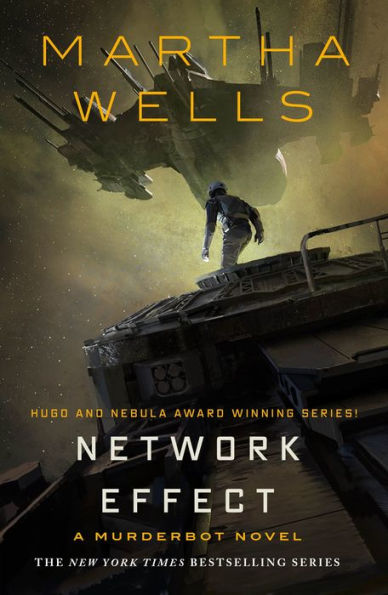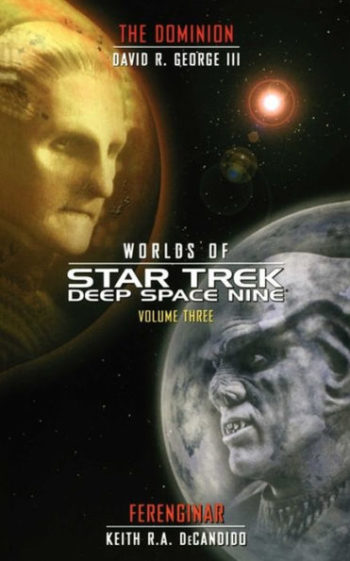Worlds of Deep Space Nine #3
The Dominion: Olympus Descending
David R. George III
Publication Date: February 2005
Timeline: December 2376, thirteen weeks after Unity
Progress: After his recent stint in the Alpha Quadrant, Odo is back in the Great Link. However, he doesn’t spend all his time in the shapeshifter sea. Sometimes he hangs out on Jem’Hadar Attack Vessel 971, buddying it up with a new Weyoun clone and a Jem’Hadar named Rotan’talag (who, like Taran’atar, is not dependent on ketracel-white).
Fellow shapeshifter Laas returns to the Great Link, bringing with him three more of the Hundred, though one is dead. Laas has some tough questions for Odo and the Link about the Hundred’s original mission. A Founder named Indurane is willing to provide some answers. The Hundred were not truly infants, as it turns out the changelings cannot procreate (but they’re also not immortal, in case you were wondering), though they were admittedly “newly formed.” The shapeshifters did not arise through a natural evolutionary process, but rather were designed, and they believe a being known as the Progenitor is responsible for this act of creation. The Hundred were sent out as a way of trying to get the Progenitor’s attention, but knowledge of their true mission was withheld in case of capture by solids.
Buy the Book


Network Effect
Odo has observed a new nova in the sky in the Omarion Nebula, and the changelings believe this heralds the return of the Progenitor. Therefore, Odo, Laas, and Indurane set out to investigate. They find a planet-sized body composed of bio-mimetic matter, which they conclude is a massive dead shapeshifter. The cause of death is radiation from the nova, apparently triggered by an isolytic subspace weapon. The likely culprit? The Ascendants.
Basic Dominion resources are now under pressure as the result of a plague that has destroyed essential food supplies on Overne III. A Vorta named Vannis, following Founder orders, demands 75% of the supplies of another planet, Rindamil III, to offset the loss, even though this action will doom millions to starvation in the near future. Vannis also tries to find out more information about the Ascendants by looking for clues in a crash site on the Sen-Ennis moon.
Meanwhile, news of the dead Progenitor hits the Great Link—including Indurane—hard, so much so that they decide to disband and disperse, leaving only Odo and Laas as the last identifiable agents of the once-mighty Dominion.
Back on DS9, Taran’atar has become angsty, feeling that his mission is a failure. He convinces the powers that be to grant him access to the Founder Leader from the war, now in solitary confinement in the maximum security facility of Ananke Alpha. His interaction with the shapeshifter does nothing to allay his fears—indeed, Taran’atar returns to the station more distressed and messed-up than before. In fact, he loses it, going on a rampage in his quarters. Kira and Ro arrive on the scene to see what’s going on, and he attacks both of them brutally and escapes on a runabout. Destination: Gamma Quadrant.
Behind the lines: In my review of Mission Gamma, Book One: Twilight, I stated that David R. George III’s “writing style didn’t work for me,” and expounded on the specifics of why. Those same trademarks I talked about there unfortunately also apply here, and I won’t belabor the point in this review. In the case of that story, the basic plot propelled me forward, but alas, I can’t make the same claim for this novel. The result was that I found The Dominion: Olympus Descending a struggle to get through.
George clearly has a strong handle on the source material, and is passionate about the details. There’s all kinds of tasty continuity here, from series-specific elements, like the history of previous Weyouns—“the sixth clone to bear the name, who during the war had defected to the Federation”—to Odo’s early days being drawn to the Omarion nebula—“a response fixed in him—in all of the Hundred—by his people, so that he—and the others—would one day return to them,” and it’s all nicely tied up with the new ideas about the Progenitor and the Ascendants. Almost an entire page dwells on Kira’s famous line to Odo—“How can you say that?”—from “Behind the Lines,” echoed by Laas’ same line here, a repetition that would make for evocative resonance if it weren’t over-explained.
As is to be expected, this narrative also integrates numerous elements from the relaunch series, including a handy recap of the events of Rising Son, but this time from Odo’s perspective. I appreciate that Taran’atar’s section includes callbacks to the events of Section 31: Abyss, like this one:
Taran’atar wondered if her captivity had impacted her emotional state, or even her mind. He dismissed the thought, even as he recalled the Jem’Hadar first on Sindorin, who had maintained that the Founders were not gods, and that the Jem’Hadar of the Dominion were no more than slaves.
I also appreciated the parallel between Sisko re-rooting himself in linear time in Bajor: Fragments and Omens and Odo using time to similarly ground himself here. Odo may not be a Prophet, but time becomes slippery inside the Great Link, an intriguing idea: “He needed separation so that he could consider things in the manner to which he’d become accustomed, and also so that he could mark time, the experience of which felt very different within the Link.” Later, again: “Even awash in his memories, Odo felt the passage of time in a way he did not within the Great Link. He’d come to understand that he needed that, needed to measure the hours and days, the weeks and months as they elapsed.”
The importance of the passage of time relates to this novel in at least two other ways. One is thematically, as it pertains to the notion of character evolution. Odo reflects upon this several times, as for instance when he sadly concludes that “neither [Weyoun or Rotan’talag] had shown any indication yet of growing beyond the bounds established for their respective species by the Founders.” It’s a personal question for Odo, naturally, since he himself continues to be pulled by both his own people and the solids, and is continually reassessing his priorities and loyalties.
Another way in which time makes itself felt is in the narrative structure itself, which emphasizes the importance of the past to understanding the present by offering us extended flashback sequences between Odo and Kira. These scenes fill in gaps regarding Odo’s explanation for his problematic actions during the Dominion war, and his reconciliation with Kira, as the sharing of his side of things eventually helped to bring them closer together. While the voices of the characters are well-handled, I thought this was a mistake, providing details we didn’t need and hampering the pace of an already incredibly slow-moving story.
I mentioned in my review of Bajor: Fragments and Omens that it felt like a transitional work, and there’s some of that vibe here too. We learn things about the Ascendants, from the fact that their “time in this part of space antedated the rise of the Founders’ empire, and few details remained of their society” to evidence of their return being at hand, through the destruction of the alleged Progenitor by the radiation of the artificially-triggered nova. (Are they also behind the plague on Overne III?) And of course, the ending—with Ro and Kira badly wounded—isn’t much of an ending at all in that sense, instead just setting the scene for David Mack’s Warpath.
While we’re on the subject, I’ll say that I think the question of the Progenitor is a potentially interesting one, as were several other ideas raised by this novel—nurture v. nature, the ethics of how the Hundred were treated, and so on. However, instead of being treated as a mystery opening up on an exciting plot of discovery, the development of the idea is mired in lengthy, pseudo-philosophical discussions of creators and first causes that failed to engage me. The eventual discovery of the dead Progenitor structure, like much else in the novel, is grim and portentous. Coupled with new characters like Vannis and Indurane that came across as undifferentiated and completely un-memorable, I found little to sustain my interest.
Compounding the aforementioned, I found Taran’atar’s “it was all a dream” scene cringe-worthy; we had to endure the unpleasantness of Kira being killed once in his imagination and then being savagely attacked again in real life, which felt needlessly repetitive and violent. This ties back to one of my other central disappointments with The Dominion: Olympus Descending, which is Taran’atar’s treatment. I feel like these events are a real step back for this character’s development, much better handled by S. D. Perry, David Weddle and Jeffrey Lang, Keith R. A. DeCandido, Robert Simpson and particularly Michael A. Martin and Andy Mangels. Whatever gains were made in those stories have essentially now been lost—a real shame.
I can see the thinking behind the choice to pair this up with Ferenginar: Satisfaction Is Not Guaranteed: a contrast between levity and seriousness, comedic relief and Very Serious Things. Unfortunately, it also highlights the difference in storytelling between Keith R. A. DeCandido and David R. George III, and I found the transition from the former’s energetic, economical prose to the latter’s ponderous, reiterative musings an unpleasant one.
Memorable beats: Odo on his people: “The irony did not escape him that a species so physically fluid could also be so mentally and emotionally inflexible.”
Orb factor: If you’re looking for answers to some of the long-burning Founder mysteries, you’ll find them (along with more questions), but for me this was a significant misstep; 3 orbs.
In our next installment:After a brief hiatus, we’ll be back in this space on Wednesday April 29th with David Mack’s Warpath!
Alvaro is a Hugo- and Locus-award finalist who has published some forty stories in professional magazines and anthologies, as well as over a hundred essays, reviews, and interviews. Nag him @AZinosAmaro.










